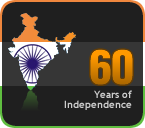An important part of the wedding is the Mapillai azhaippu – introducing the mappillai or the bridegroom to the local residents and the bride’s relations.
Once the bridegroom’s party was well-fed and rested after their arrival, they were taken to the local temple in the evening to get God’s blessings. A pooja would be performed by the priest.
Inside the temple, the bride’s brother welcomed him with a garland and applied sandal paste on his arms and presented him with a new set of veshti. From the temple the bridegroom and the entourage were taken to the wedding pandal in a slow procession with the accompaniment of nadaswaram and gaslights. In the early days it was a procession on foot, with the bridegroom garlanded. But even here changes came over gradually, and the bridegroom was seated in an open coach drawn by slow trotting horses.

The decorated car at the wedding of my son-in-law's sister in the early 60s
When motorcars came on the scene, instead of the carriage, an open car, well decorated with flowers and festoons was used for this. And along with this change, the bridegroom’s veshti changed to western clothes – a suit with shoes to add. As the English culture seeped into our custom, this kind of procession was give up by many modern minded families. And nowadays it is practically obsolete, except in a few cases.
When the bridegroom’s procession reached the wedding pandal, he and his relatives were welcomed ceremoniously with aarathi and thamboolam by the bride’s parents, and conducted to the wedding dais.
Here the purohits were waiting with everything ready for the next ceremony, the formal engagement. The bridegroom was garlanded afresh by the bride’s brother.
I have no memory of my mother telling me if the child bride was seated next to the bridegroom. I have seen in one or two weddings of the 1960s, the bride was excluded from this engagement ceremony. She never came to the pandal. But later on as customs changed, the bride was brought to the pandal, well decked. She was received by the bridegroom’s sister with a garland and kumkumam. Later on the practice of gifting jewellery to the bride became a part of this ceremony.
Among the chanting of the sacred mantrams and the strains of the nadaswaram, thamboolam was exchanged by the father s of the couple in the presence of elders. This exchange was considered the formal engagement.
After this the bride and groom had to perform obeisance (namaskarams) to all senior members of both families, taking care not to leave out anyone. Otherwise this omission would be held against them for life, which was not uncommon in those days.
Once the nichiyathartham was over the bridegroom’s people were led into the house for dinner. Here banana leaves were spread on the floor, the food being served on them. And people would be seated on durries or mats to partake of the feast. This meal being the first of the actual wedding ceremonies, was a grand one with pal payasam boli and vadai, as well as many varieties of vegetables, chips and pickles.
After the meal the men and women would sit on different sides of the pandal and offered betel leaves and nuts to chew on. They were escorted back to the house arranged for them and left there for the night.
In those days the wedding ceremonies lasted five days. People generally had a lot of time on their hands, and the wedding season started only after the harvest. The only entertainment they had was a temple festival or a harikatha kalakshepham. So ceremonies like weddings and upanayanams were conducted for five days.
A five day wedding gave enough time for the bridegroom’s party to get over the tiredness of the onward trip, and ready them for their return trip.
On each day of the wedding all the meals had to be served with different menus with a different pradhaman (essentially a Kerala sweet dish prepared with jaggery and coconut milk) each time. Unlike today, pradhamans were served until everyone was fully satiated.
A certain decorum would be observed by the bride’s family to their sammandhis on all these five days. Early morning coffee, breakfast (idly, vadai and a sweet made with jaggery), and evening tiffin (sojji and bajji) were to be sent to the bridegroom’s place on time and in plenty.
For lunch and dinner, each time men and women from the bride’s family would go over to where the bridegrooms’ family was staying, taking thamboolam and accompanied by nagaswaram, and request each and everyone , without leaving anyone out, to come and partake of the meal. On the day of the muhurtham also, along with the thamboolam a sweet preparation made with milk, and paruppu thengai were included to invite the bridegroom’s people. The paruppu thengai is a sweet prepared with jaggery,roasted chickpeas and coconut bits, and shaped like a cone, a symbol of prosperity and progeny.
A word about the nadaswaram. Nadaswaram was and is an essential part of the wedding ceremony. The then famous Ambalappuzha Brothers were the artistes who played the nadaswaram at my sister’s and my weddings. During the mappilai azhaippu, nicihyathartham on the day of the wedding, would be non-stop music, and the scale wedding was judged by the name of the nadaswaram player.
In the 1980s when my youngest daughter got married in Delhi, the event manager had arranged for the nadaswaram players to come from the south. It was something novel in New Delhi and was appreciated by one and all. Many of our friends and acquaintances congratulated us on the grand wedding.

At the wedding reception of Gowri and Mohan (left), Babuji shares a joke with a guest.
More to come......






4 comments:
Great reading Ma and I love the pictures : )
Blog-hopped onto your space and loved your writings.
Read the archives and enjoyed every single post.
wow, maiji maami, its so different from what i know of weddings, although there is some similarity! the pictures look lovely, even though they're old! the pictures are one of the highlights of your blog, along with your writing, makes me a fan!
Pretty helpful data, lots of thanks for your post.
Post a Comment